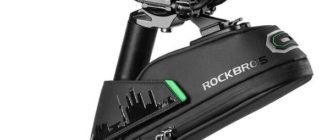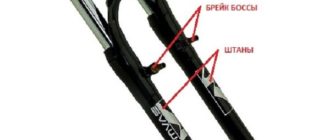The suspension fork is one of the most important components of any mountain bike. The condition and functionality of this element determines the behavior of the bike on any surface other than smooth and flat asphalt. To get the most out of the mountain bike, you need to know how to adjust the bike fork stiffness and make the necessary adjustments to this component.
Varieties and configuration of bike suspension forks
Most often, the shock absorber consists of 4 main components:
- The upper part (popularly called “legs”). On the smoothness of the course of this component depends on the study of small bumps in the road.
- The damper is an adjustable inner part of the “legs”, which has several tuning options.
- Stem and fork crown. These mechanisms account for the bulk of the load on the steering tube side.
- The lower part, which is popularly known as the “pants”, is filled with oil and also has several variations of adjustment.
The current variety of bikes has spawned an equally varied set of bikes. Manufacturers are constantly working to ensure that professional athletes and ordinary cyclists can enjoy the use of mountain bikes. Therefore, today we can distinguish a separate classification of forks by their type:
- Spring and spring-elastomeric. Equipment of this type is more common on budget bikes. Repair and maintenance does not cause difficulties, but this fork very poorly reflects minor bumps. The most ordinary spring is used as a base. The mechanism is easily contaminated and, as a rule, does not provide a wide range of adjustments. Maintenance of such a mechanism is limited to a simple replacement of the spring. Both types are extremely vulnerable to low temperatures.
- Air Forks. Optimal combination of price and ease of maintenance combined with light weight (relevant for those who want to reduce the weight of the bike). Compressed air in a sealed chamber acts as a shock absorber, and sometimes serves as a damper. Riding on such forks is much more comfortable, but there are a few nuances. However, careful operation and timely maintenance will ensure a long service life of the mechanism.
- Spring fork with oil. This is the best option for aggressive use of the bike. The mechanism consists of an oil cartridge and a spring made of titanium or steel. This is the most productive and wear-resistant fork, which most often comes with bikes from well-known manufacturers (e.g., Land Rover) for professional athletes.
Given the classification, we can conclude that the correct adjustment of stiffness ensures not only the comfort of riding on rough terrain, but also the endurance of the mechanism and its durability.
Types of adjustments
Immediately say that this information applies for the most part on the equipment of the medium and high levels – budget models do not have several variations of adjustment, and are usually operated with the standard factory modes.
Modern manufacturers of suspension forks for professional mountain bikes and mid-level bikes offer consumers a manual, which contains all the necessary information on the settings. Common types of adjustments:
- Preload. This type is found in almost all models of suspension forks. Most often it is located at the top of the “legs” and determines the fork slack under the weight of the cyclist in a static position (sag). In budget models it has no obvious effect on fork performance. In more expensive bikes this figure should be adjusted to 10-20% of the total fork travel. On products of the spring type, it is enough to compress or replace the spring with a part with a different degree of rigidity. On air models – change the pressure in the positive chamber.
- rebound. The adjustment determines the rate at which the fork rebounds after compression. This is an important setting that allows you to adjust the mechanism depending on the specifics of a particular ground. For highways and smooth paved roads, you can adjust to a slow rebound speed. In all other cases, you should adjust the fork based on personal preference and road characteristics. Advanced models can calibrate the rebound speed on their own, the simplest forks do not have the ability to adjust it.
- Compression speed. A parameter that is responsible for the compression speed of the fork as a result of impact from the surface. There are two types: high speed compression and low speed compression. The latter (Low-compression) is one of the most important and widespread adjustments, which allows maximum fine-tuning of especially sensitive forks when handling small bumps in the road, to level out the sway when pedaling, as well as to redistribute weight when entering a turn, etc. High-speed compression is responsible for adjusting the fork on the more noticeable defects of the track (e.g., when landing from a springboard). This type of adjustment is found in suspension forks designed for extreme bikes.
- Adjustment of fork stroke length. A primitive option is to lock the fork mechanically. It can be found even on the cheapest models. More advanced mechanisms have a gradual stroke adjustment function, which greatly expands the scope of the bike’s use on any trail.
- Compression spring (positive spring). In the simplest mechanisms is located at the top of the “leg” (the so-called “plastic drums”, which may be present on one or both sides of the legs). With this adjustment, an acceptable sag can be achieved. In mid- and high-priced mechanisms, in order to significantly change the compression stiffness, the spring will have to be replaced. In air dampers, the adjustment is made by changing the air in the positive chamber.
- The rebound spring (negative spring). The adjustment allows you to calibrate the response of the fork to minor bumps. The rebound spring is much easier to adjust on forks with an air negative chamber.
Most shock-absorbing forks have a locking function. It is necessary when riding Uphill—how-to-learn–tips or on long straight sections. It is important to turn on this function in time to avoid the possibility of hitting your hands when you hit a rough patch of road. Proper adjustment of the shock absorber – the key to a comfortable ride and the “health” of the bike. By the way, springs from well-known manufacturers differ in color, which corresponds to different degrees of stiffness.
Adjusting the rigidity of the bike fork
This parameter allows you to calibrate the softness of the shock absorber. Standardly located at the top of the “legs”. In its normal position, the damper dampens vibration while maintaining spring stiffness on level roads. Adjustment allows you to adjust the distance between the upper and lower point of maximum pressure. Several types of loading are distinguished:
- Minimum stiffness. The soft stroke of the fork provokes the appearance of discomfort due to the sharp oscillation of the spring during the rotation of the pedals.
- High stiffness. Not the best parameter, as the adjustment does not allow the shock absorber to qualitatively handle small irregularities.
- Optimal setting. This is the golden mean, where the fork absorbs shocks as well as possible, improving the dynamic performance of the bike.
A good setting is achieved when about 70% of the fork’s travel is left on the bike after the rider sits on it. The type of shock absorber is also important. For example, in the air fork the degree of stiffness is calibrated by pumping air, in the spring – press or change the spring, in simple models, changing the stiffness will not show a significant change at all.
Compression adjustment
This parameter is designed to calibrate the compression rate of the front shock absorber and ensures its even travel and smooth bounce back. The adjustment comes down to adjusting the compression rate of the fork under the influence of shock from uneven surfaces. Intermediate and professional level mechanisms have 3 settings:
- Low Speed. It allows to decrease the sensitivity of the mechanism on small irregularities, but at the same time it dampens the powerful blows.
- High Speed. Proper calibration provides efficient processing of the smallest bumps, but the fork is easily punctured by the following strong impacts.
- Locking. This is a total stiffness mode that can be used while riding on completely flat areas.
Some air-spring mechanisms have an adjustment function separately in each chamber. This is very useful in the design of bicycles for the woods and the city, when the smooth asphalt alternates with light off-road, smoothly transitioning to loose ground.
Rebound speed adjustment
This feature is not found on budget machines. Rebound speed is the time it takes for the fork to return to its original position to handle further obstacles. Settings:
- On highways and smooth stretches of road, it’s best to set the rebound to slow.
- In all other cases, you should adjust the speed based on terrain and personal preference.
In any case, the bounce rate should be optimal, in order to avoid unpleasant bumps on the hands. With the right setting, the impact is damped rather than “shot” into the hands, and the fork has time to decompress to overcome the next obstacle.
Algorithm for lining up the bounce on the move:
- find an area with few bumps;
- set the fork to the slowest bounce;
- increase the speed to determine the force of the impact on the handlebars;
- calibrate the fork until the bumps in your hands stop.
It is important to make sure that the bumps from the bumps come to the shock absorber and not to the handlebar or the front wheel. And one more important point – it is not recommended to tune the fork at once. You should stick to a certain sequence: preload (fork stiffness) – compression – rebound. Only by painstaking and careful tuning of the suspension fork you can find the perfect balance and get even more enjoyment out of Cross-country—what-it-is–nuances riding.
Tips
Technically, the care of this mechanism is not particularly difficult. With certain skills and some tools, all the work can be done by yourself. Let us outline a few steps:
- Dismantling the bike fork. In general, there is nothing complicated here – you only need to understand the peculiarities of the mount.
- Cleaning the mechanism. Any dirt, dust and sand that got inside the shock absorber, will soon lead to failures in its work and, possibly, to failure. Therefore, fork cleaning and lubrication should be a mandatory procedure, which is desirable to repeat once a year.
- Changing the oil and lubricating the spring. It is desirable to perform every season and use only proven compounds from reputable manufacturers.
Experienced repair masters advise not to delay with the maintenance of the shock-absorbing fork when the very first “bells” in the form of specific sounds or the appearance of atypical bumps. Prompt intervention will avoid more serious problems and complete replacement of the entire mechanism.
Conclusion
There is nothing complicated about tuning the shock-absorbing fork. Quality calibration allows you to effectively overcome off-road and use the bike in a gentle mode. Timely maintenance of the shock absorber significantly increases its service life and reduces the likelihood of serious problems.









